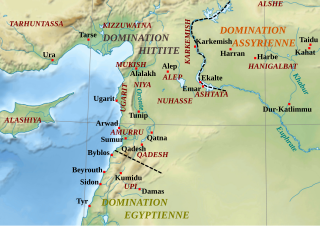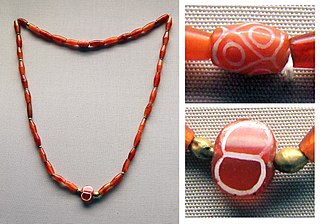
Ebla was one of the earliest kingdoms in Syria. Its remains constitute a tell located about 55 km (34 mi) southwest of Aleppo near the village of Mardikh. Ebla was an important center throughout the 3rd millennium BC and in the first half of the 2nd millennium BC. Its discovery proved the Levant was a center of ancient, centralized civilization equal to Egypt and Mesopotamia and ruled out the view that the latter two were the only important centers in the Near East during the Early Bronze Age. The first Eblaite kingdom has been described as the first recorded world power.

Mesannepada (Sumerian: 𒈩𒀭𒉌𒅆𒊒𒁕, Mesannipàdda [MES-AN-NE2-PAD3-DA]), Mesh-Ane-pada or Mes-Anne-pada ("Youngling chosen by An") was the first king listed for the First Dynasty of Ur (c. 26th century BC) on the Sumerian king list. He is listed to have ruled for 80 years, having overthrown Lugal-kitun of Uruk: "Then Unug (Uruk) was defeated and the kingship was taken to Urim (Ur)". In one of his seals, found in the Royal Cemetery at Ur, he is also described as king of Kish.

Mari was an ancient Semitic city-state in modern-day Syria. Its remains form a tell 11 kilometers north-west of Abu Kamal on the Euphrates River western bank, some 120 kilometers southeast of Deir ez-Zor. It flourished as a trade center and hegemonic state between 2900 BC and 1759 BC. The city was built in the middle of the Euphrates trade routes between Sumer in the south and the Eblaite kingdom and the Levant in the west.

The first dynasty of Ur was a dynasty of rulers from the city of Ur in ancient Sumer who reigned c. 2600 – c. 2340 BC. Ur I is part of the Early Dynastic III period of ancient Mesopotamia. It was preceded by the earlier First Dynasty of Kish and the First Dynasty of Uruk.

Meskalamdug was an early Sumerian ruler of the First Dynasty of Ur in the 26th century BCE. He does not appear in the Sumerian King List, but is known from a royal cylinder seal found in the Royal Cemetery at Ur, a royal bead inscription found in Mari, both mentioning him as King, and possibly his tomb, grave PG 755 at the Royal Cemetery at Ur.

Nuhašše, was a region in northwestern Syria that flourished in the 2nd millennium BC. It was east of the Orontes River bordering Aleppo (northwest) and Qatna (south). It was a petty kingdom or federacy of principalities probably under a high king. Tell Khan Sheykhun has tenatively been identified as kurnu-ḫa-šeki.
Armi, was an important Bronze Age city-kingdom during the late third millennium BC located in northern Syria, or in southern Anatolia, Turkey, at the region of Cilicia.

Armani was an ancient kingdom mentioned by Sargon of Akkad.

The Royal Cemetery at Ur is an archaeological site in modern-day Dhi Qar Governorate in southern Iraq. The initial excavations at Ur took place between 1922 and 1934 under the direction of Leonard Woolley in association with the British Museum and the University of Pennsylvania Museum of Archaeology and Anthropology in Philadelphia, Pennsylvania, United States.
Vizier, is the title used by modern scholars to indicate the head of the administration in the first Eblaite kingdom. The title holder held the highest position after the king and controlled the army. During the reign of king Isar-Damu, the office of vizier became hereditary.
Iblul-Il, was the most energetic king (Lugal) of the second Mariote kingdom, noted for his extensive campaigns in the middle Euphrates valley against the Eblaites, and in the upper Tigris region against various opponents, which asserted the Mariote supremacy in the Syrian north.
Hanun-Dagan, was the Shakkanakku and king (Lugal) of Mari reigning c. 2016-2008 BC. He was the brother of his predecessor Hitlal-Erra, and is recorded as the son of Shakkanakku Puzur-Ishtar on a seal discovered in the city. Although the title of Shakkanakku designated a military governor, the title holders in Mari were independent monarchs, and nominally under the vassalage of the Ur III dynasty. Some Shakkanakkus used the royal title Lugal in their votive inscriptions, while using the title of Shakkanakku in their correspondence with the Ur's court, and it is certain that Hanun-Dagan used the royal title.
Saʿumu was a king (Lugal) of the second Mariote kingdom who reigned c. 2416–2400 BC. Some scholars, such as Joseph Martin Pagan, interpreted the king's name as derived from the root "ś-y-m", a cognate of the Akkadian word "šâmu-m", meaning "to buy".
Kun-Damu was a king (Malikum) of the first Eblaite kingdom ruling c. 2400 BC. The king's name is translated as "Arise, O Damu". Kun-Damu is attested in the archives of Ebla dated two generations after his reign. According to Alfonso Archi, he was a contemporary of Saʿumu of Mari. The archives of Ebla records the defeat of Mari in the 25th century BC, and based on the estimations for his reign, Kun-Damu might be the Eblaite king who inflicted this defeat upon Mari. Aleppo might have came under the rule of Ebla during his reign. Following his death, he was deified and his cult was attested in Ebla for at least 30 years after his reign.
Ishtup-Ishar (Ištup-Išar) was a king (Lugal) of the second Mariote kingdom. The king's name was traditionally read as Išhtup-šar, with šar being a common divine element in personal names attested in the region. However, the king's name is read as Ishtup-Ishar by Alfonso Archi, Ishar being an important justice deity worshiped in Mari and Ebla.

Ikun-Mari was a king (Lugal) of the second Mariote kingdom. His name was recorded on a stone jar mentioning his wife "Alma". The script's style on the jar suggest a date later than the reign of the Mariote king Ikun-Shamash but earlier than the reign of king Isqi-Mari.

A-Imdugud, was an early ruler of the First Dynasty of Ur in the 27th century BCE. He does not appear in the Sumerian King List, but is known from an inscribed seal found in tomb PG 1236 in the Royal Cemetery at Ur, which is the largest and probably the earliest tomb structure at the cemetery.

Etched carnelian beads, or sometimes bleached carnelian beads, are a type of ancient decorative beads made from carnelian with an etched design in white, which were probably manufactured by the Indus Valley civilization during the 3rd millennium BCE. They were made according to a technique of alkaline-etching developed by the Harappans, and vast quantities of these beads were found in the archaeological sites of the Indus Valley civilization. They are considered as an important marker of ancient trade between the Indus Valley, Mesopotamia and even Ancient Egypt, as these precious and unique manufactured items circulated in great numbers between these geographical areas during the 3rd millennium BCE, and have been found in numerous tomb deposits.

























